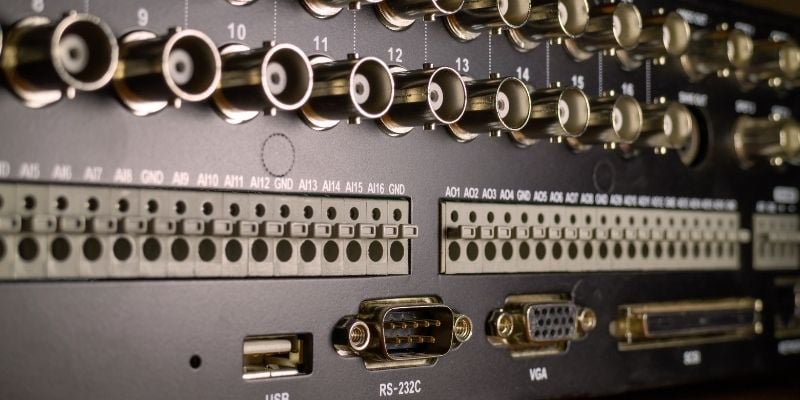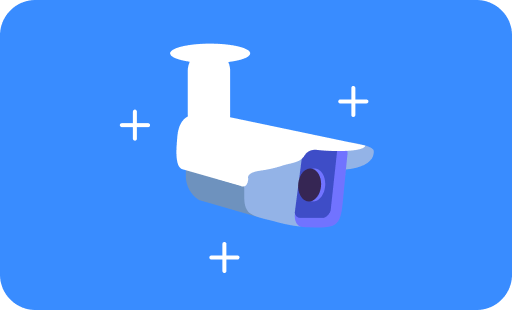NVR vs DVR: what's the difference and which is better?
- Featured Post
- Physical security
- FILTER_Physical-Security

Understanding the difference between NVR and DVR is key to deciding which video surveillance system you want. Both systems record and store video, but they process it differently; they also differ in running costs, video quality and site coverage. We’ll explain how they work as well as the pros and cons of each option.
NVR vs DVR: what’s the difference?
DVR is a Digital Video Recorder, and NVR is a Network Video Recorder. Both NVRs and DVRs record video data transmitted from security cameras, storing it in a format that you can access later. They differ in how they handle that data.
In a DVR system, video is recorded from analog cameras. As the name suggests, analog cameras cannot process raw video data at the source (i.e. within the camera itself). Instead, analog cameras transmit a raw video signal to the DVR along coaxial cables. The DVR processes this signal into a digital format that can then be stored and viewed remotely.
In an NVR system, we capture video from IP (internet protocol) cameras. Unlike analog cameras, IP cameras can process video data at the source. The processed video data is then sent to the NVR over an ethernet cable, or by wifi. IP cameras usually offer much higher resolution than analog cameras. The NVR still records data in a digital format, but it does not process the data as this has already taken place within the IP camera.
How does a DVR (digital video recorder) system work?
Let’s revisit the camera to recorder process for a DVR system:

Previously known as CCTV cameras, analog cameras produce a raw video signal. They don’t have all the bells and whistles of IP cameras, and usually the video quality is not as high - although there have been advances to offer improved analog resolution. On the whole, their lower specs make them more affordable than IP cameras.
Since all the recording is done in the DVR itself, it is possible to transmit the raw video signals of many different camera models on one system. This makes DVR a great option for sites with cameras of varying brands and models. As we’ll see later, IP cameras encode the video signal before transmission to the NVR, which can create some compatibility issues.
The coaxial cable carries the raw video signal from the camera to the DVR for image processing. It does not power the cameras, but there are options available with an integrated power splitter, to carry out both functions from one cable. Similarly, they don’t transmit audio signal, but RCA phono connectors enable you to record this if you want. Combining all these cables into one makes it easier and neater when you’re installing your system!
There are some practical considerations with a DVR system. Coaxial cables are bulkier and more rigid than ethernet cables and you will need one for every camera. They also use large BNC connectors, which along with the cables, make this option tricky to install for sites with small or awkward spaces. The issue of powering your cameras also means that you need to position your DVR (and all linking cables) near a power source.
If you do decide to add audio with an RCA connector, choose carefully which cameras will do this, since there are a limited number of audio input ports on a DVR.
Another factor to consider when laying out a DVR system is the distance between cameras and the recorder. If you exceed 300 feet / 90 metres of cable, the video signal begins to degrade, compromising the quality of your recording. The quality of your coaxial cables will also have an impact on the distance at which signal degrades - with a cheap cable, the distance could be shorter.
How does an NVR (network video recorder) system work?

An NVR security system uses newer technologies, such as internet connectivity, to make video surveillance easier and more flexible. NVR security systems connect to IP cameras, which capture video and process it all in one, sending the encoded (digitised) video to the NVR via an internet connection.
There are two ways an IP camera can connect to an NVR:
PoE (Power over Ethernet) connection - this is a wired internet connection using an ethernet cable. Wired internet access offers a fast, reliable and secure connection to a local area network (LAN). Ethernet connectors are fairly small and compact, and the cable itself is slim and easy to manipulate in small spaces. They are also cheaper and much more widely available than coaxial cables. They have the added benefit of providing power and audio/video transmission all in one cable.
Unlike coaxial cables, video transmitted via internet over long distances won't change in quality; if you want to extend to distance of your cameras from your recorder, it is possible to do this with network switches without compromising video quality.
Wireless / wifi connection - some cameras can connect wirelessly to an NVR over wifi. Even in a PoE-connected camera network, not every camera requires a cable back to the recorder, so check if your ethernet system can support multiple cameras on a wireless network. This gives you much more freedom to place cameras where you want, since you aren’t restrained by the difficulties of installing wires or cables.
Wifi is not always as reliable as ethernet, meaning there is a risk of interference and signal loss which could compromise your recordings. If your network security isn’t high, there is also the risk that your system could be hacked.
Many IP cameras can do much more than just capture video, with added features including audio recording and ‘on edge’ video analytics. The image quality of IP cameras is also much higher than that of analog cameras.
However, not all IP cameras are compatible with all NVR systems. Before installing either the cameras or the recorder, check that your devices are compatible. If you’re buying a new system or upgrading all your cameras, this can entail a greater upfront cost than an analog/DVR system.
NVR vs DVR: weighing up the pros and cons
| DVR pros | DVR cons | NVR pros | NVR cons |
|---|---|---|---|
| Equipment is cheaper to install and run | Coaxial cables are bulky, making it hard to install in all areas | Ethernet cables are thinner and easier to install | Higher installation and equipment costs |
| Can mix and match camera brands and models on one DVR | System must be installed near a separate power supply | IP cameras can be installed almost anywhere, especially wifi (wireless) cameras | Certain NVRs are not compatible with certain camera brands and models |
| No internet connection means no cybersecurity threats to consider | Coaxial cables exceeding 90m / 300ft will degrade signal, so site coverage is limited | Internet connection means there is no limit to cable length, so site coverage is much wider | Wifi connections are less reliable, and any network connection poses cybersecurity risks |
| Possible to integrate new equipment into legacy systems | Lower quality video and limited audio capability, and no additional features | Higher quality video and audio capability on all cameras. Added features include licence plate recognition, facial recognition, motion detection, and more | The life cycle of IP cameras is shorter than analog, making them costly to replace frequently |
As you can see, there is no clear-cut case for or against either system, since both are effective and reliable. It really depends on your budget and how you plan to use it. If you want the best of the best, there’s no doubt that IP cameras and an NVR system will give you higher-quality video, audio, and the benefit of video surveillance over an internet connection. However, if you are looking for video surveillance that won’t break the bank and will last for many years, you can’t go wrong with analog cameras and a DVR system.
Enhancing your NVR or DVR system with video analytics
You can also benefit from an additional layer of intelligence by integrating video analytics. This applies to both NVR and DVR systems, since the AI that powers intelligent video analytics like Calipsa can pick up on events that on edge camera analytics are not always capable of. Many video analytics solutions operate at the server level, which means that DVR systems can also access enhanced video surveillance.
Some analytics solutions - such as Calipsa’s Pro Analytics - go one step further and operate from the cloud. This allows both NVR and DVR systems to benefit from intelligent video analytics cheaply and at scale. A cloud solution is not restricted by location, and is easy to integrate into many different NVR or DVR systems, so if you have a mixture of hardware across various sites, the same analytics can enhance all your video security.
Learn more about Calipsa's cloud-based, AI-powered Pro Analytics and how they can enhance your video surveillance system.







5 comments